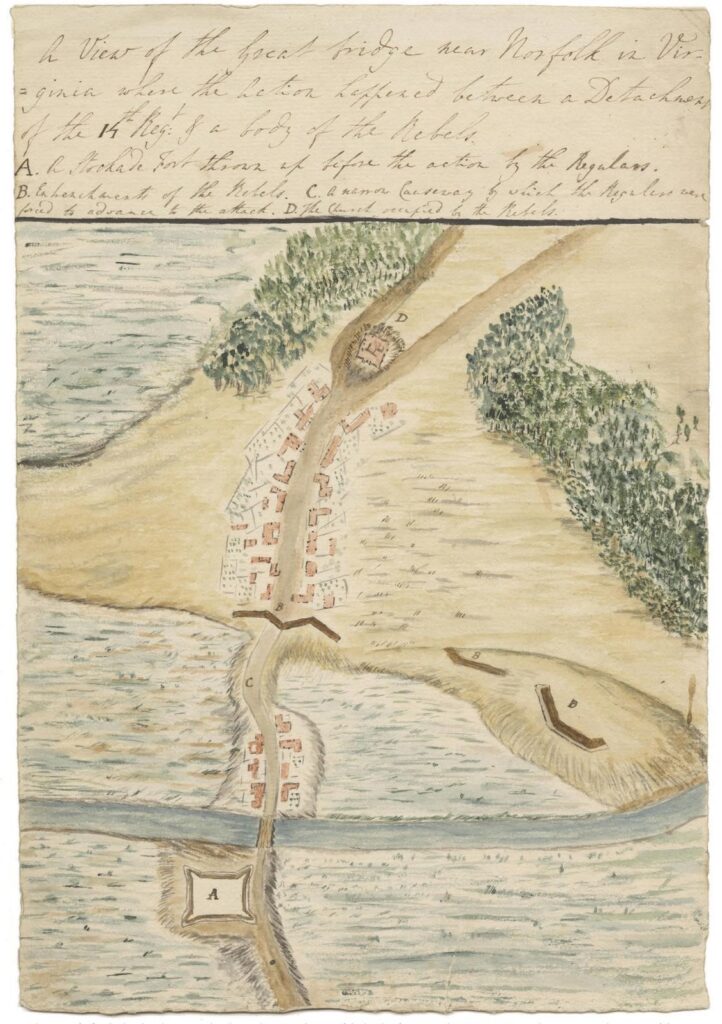
Department of Historic ResourcesAn official website of the Commonwealth of Virginia Here's how you knowAn official websiteHere's how you know

Department of Historic ResourcesAn official website of the Commonwealth of Virginia Here's how you knowAn official websiteHere's how you know
Virginia Department of Historic Resources
(dhr.virginia.gov)
For Immediate Release
January 11, 2024
Contact:
Ivy Tan
Department of Historic Resources
Marketing & Communications Manager
ivy.tan@dhr.virginia.gov
804-482-6445
—The easement protects property associated with the Battle of Great Bridge, a strategic victory for Patriot militia during the American Revolution—
RICHMOND – The Department of Historic Resources (DHR) announced today that a perpetual historic preservation easement has been executed and recorded over property associated with the Battle of Great Bridge, the first major armed conflict of the American Revolutionary War in Virginia. The easement protects the 0.664-acre property from subdivision and future development.
Known as the Mair Tract, the property lies entirely within the Great Bridge Battlefield in the City of Chesapeake. The Mair Tract adjoins the Great Bridge Battlefield & Waterways Historic Park—commonly called Battlefield Park—that was established to commemorate the Battle of Great Bridge, which occurred on December 9, 1775. Formerly enslaved men in the Ethiopian Regiment participated in the Battle of Great Bridge, further adding to the battle’s historical significance.
Threatened with rebellion in late summer 1775, Virginia’s Royal Governor Lord Dunmore ordered the Royal Marines of the H.M.S. Magdalen to seize gunpowder stores in Williamsburg, the colonial capital. Patriot militia units converged in Williamsburg after word of Dunmore’s order spread. Dunmore subsequently fled to Norfolk, situated 12 miles north of the Mair Tract, and Portsmouth. He then began to raise an army. Dunmore declared martial law on November 7 and issued a proclamation that promised freedom to any enslaved person who entered military service. He organized these recruits into the Ethiopian Regiment and tasked them with raiding Patriot militia camps.
The primary entry to Norfolk in 1775 was the Great Bridge that spanned the Elizabeth River, located just north of the Mair Tract. The Great Dismal Swamp surrounded the bridge, which was accessible only through narrow causeways along the north and south. Recognizing the strategic importance of the bridge, Dunmore ordered a stockade known as Fort Murray to be constructed on the north side of the Elizabeth River, opposite the village of Great Bridge.
On December 7, Patriot forces gathered on the south side of the bridge. Over the next few days, Royal and Patriot troops engaged in the nearby bogs and swamps. By December 9, Dunmore’s troops, including the 14th Regiment of Foot and the Ethiopian Regiment, attacked the Great Bridge village and Patriot fortifications. The British staged their attack from the Mair Tract and its vicinity. During the fighting, British infantry and grenadiers crossed the property and advanced along the narrow causeway to the Great Bridge. Patriot troops quickly attacked British soldiers confined within the causeway.
At the end of the battle, the British abandoned Fort Murray and retreated to Norfolk. Soon after, Patriot forces entered Norfolk, which forced Dunmore and his troops to flee Virginia. As a direct result of the Patriots’ victory in the Battle of Great Bridge, the Virginia Convention adopted the first public declaration expressing a spirit of independence.
The American Battlefield Trust (ABT) acquired the Mair Tract in 2019 through, in part, funding from the American Battlefield Protection Program, the Virginia Battlefield Preservation Fund, and City of Chesapeake grants. As a requirement of these grants, ABT donated the easement to the Virginia Board of Historic Resources (VBHR) in 2023. ABT intends to transfer ownership of the Mair Tract to the City of Chesapeake, which owns portions of Battlefield Park. The city plans to incorporate the property into Battlefield Park.
As of 2023, DHR has placed under easement more than 45,000 acres of land in Virginia. DHR easements are held by the VBHR, and DHR staff monitor the eased lands. The VBHR currently holds easements on approximately 15,900 acres of battlefields in the Commonwealth.
About the Great Bridge Battlefield & Waterways Historic Park
Simply referred to as Battlefield Park, this historic park contains portions owned by the City of Chesapeake and the Unites States Army Corps of Engineers. The on-site museum is overseen in partnership with the Great Bridge Battlefield & Waterways History Foundation, a nonprofit organization dedicated to preserving and promoting the history of the 1775 Battle of Great Bridge as well as the economic and cultural contributions made by the Albemarle and Chesapeake Canals and the Dismal Swamp in America’s creation and road to independence. Battlefield Park is open to the public and includes a visitor’s center, exhibits, monuments, an interpretative historic pathway, trails, and other associated amenities. For more information, visit gbbattlefield.org.

###
Programs
DHR has stimulated more than $4.2 billion dollars in private investments related to historic tax credit incentives, revitalizing communities of all sizes throughout Virginia
DHR has secured permanent legal protection for over 700 historic places - including 15,000 acres of battlefield lands
DHR has erected 2,532 highway markers in every county and city across Virginia
DHR has registered more than 3,317 individual resources and 613 historic districts
DHR has engaged over 450 students in 3 highway marker contests
DHR has stimulated more than $4.2 billion dollars in private investments related to historic tax credit incentives, revitalizing communities of all sizes throughout Virginia
DHR has secured permanent legal protection for over 700 historic places - including 15,000 acres of battlefield lands
DHR has erected 2,532 highway markers in every county and city across Virginia
DHR has registered more than 3,317 individual resources and 613 historic districts
DHR has engaged over 450 students in 3 highway marker contests
DHR has stimulated more than $4.2 billion dollars in private investments related to historic tax credit incentives, revitalizing communities of all sizes throughout Virginia